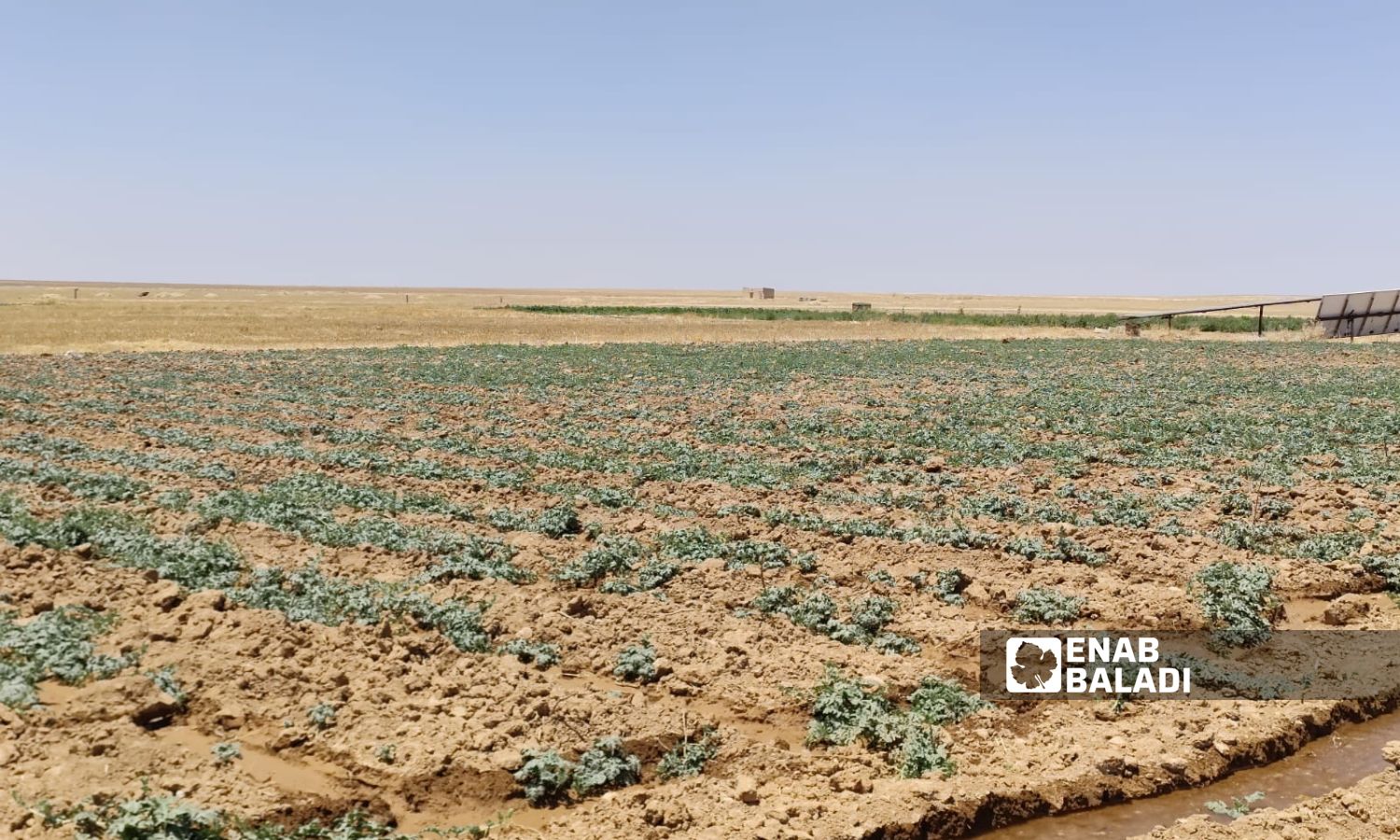



Enab Baladi – Ras al-Ain
The region of Ras al-Ain, located in the northwest of al-Hasakah, is witnessing an increase in the cultivation of seeded watermelons. This move aims at selling the seeds at prices that leave a profit margin for the farmers.
Ras al-Ain farmers are striving to improve their income by diversifying their crops and compensating for the financial losses they have suffered in past years from staple crops like wheat and cotton, as well as secondary crops like cumin.
The planting of seeded watermelons starts at the beginning of July, and harvesting begins in mid-October each year. Unlike sweet watermelon, seeded watermelon fruits are slightly smaller and contain many seeds with little pulp, in contrast to red watermelon known for its large red pulp and few seeds inside.
Omar Hamoud, head of the Agriculture Office in the local council of Ras al-Ain, stated that the area planted with seeded watermelon in Ras al-Ain reached about 11,000 dunams.
He told Enab Baladi that seeded watermelon can yield abundant production if given proper care and protection from fungi.
He mentioned that the farmers’ preferred variety is “Hobodi” due to its high productivity and its ability to withstand harsh climatic conditions, including water scarcity.
He pointed out that the directorate provided facilities to farmers, including consultations and plowing equipment from the local council at cost prices, within available possibilities.
Seeded watermelon is considered an intensive crop, as three crops can be grown in two years. It is characterized by its high prices and low expenses, with minimal water requirements.
The agricultural area in Ras al-Ain is 1.270 million dunams, of which 200,000 dunams are cultivated, while the rain-fed area exceeds 420,000 dunams.
Farmers turned to watermelon seeds due to their high selling prices, with the price per ton of seeds ranging between $800 and $1,400 in 2023 (USD 1 = 15,000 SYP).
Farmer Adnan al-Sami from Ras al-Ain told Enab Baladi that planting seeded watermelon and selling its seeds is not new to the area, as it is planted immediately after the wheat season and harvested before the cotton season.
He explained that growing watermelon is an annual practice for him, dedicating 60 dunams each year to its cultivation, due to the ease of marketing watermelon seeds and the traders’ interest in buying them.
The farmer added that the cost of planting one dunam is $9 (equivalent to 135,000 SYP), which includes labor and pesticide expenses.
He noted that watermelon seeds are sold directly, and traders seek to purchase, store, and sell them at high prices in markets, unlike staple crops.
Meanwhile, farmer Hussein al-Karim planted about 50 dunams of seeded watermelon this year after the wheat season. He said he has planted it for more than ten years due to its low associated costs and good profits.
He told Enab Baladi that it is the only crop he does not regret planting because of its abundant production and easy marketing, noting that seeded watermelon provides financial stability and good returns.
One dunam of seeded watermelon produces between 500 and 1,000 kilograms of seeds, with the price per ton ranging between $800 and $1,400.
The farmer sells the seeds directly to traders after using a machine that separates the watermelon from the seeds, then dries and packages them in special bags before selling them to the trader.
Agricultural engineer Marwan al-Ghazi said that cultivating seeded watermelon is relatively easy compared to some other crops.
He explained to Enab Baladi that this crop needs well-drained soil and regular care, including adequate irrigation to ensure the proper growth of the plant.
The engineer added that the appropriate use of fertilizers is essential to improve production quality, along with the importance of regularly monitoring the plants to combat pests and fungal diseases.
Al-Ghazi pointed out that the demand for sweet watermelon cultivation is very limited compared to seeded watermelon due to its low production.
He mentioned that seeded watermelon yields higher production and brings good financial returns, making it a preferred choice for farmers over sweet watermelon.
Agriculture, along with livestock breeding, is one of the main professions of the majority of the residents in the Ras al-Ain area and northern and northeastern Syria, constituting a primary source of income for these regions.
Agricultural crops in Ras al-Ain face marketing difficulties, trader control, and the absence of government entities purchasing strategic crops in the area.
if you think the article contain wrong information or you have additional details Send Correction